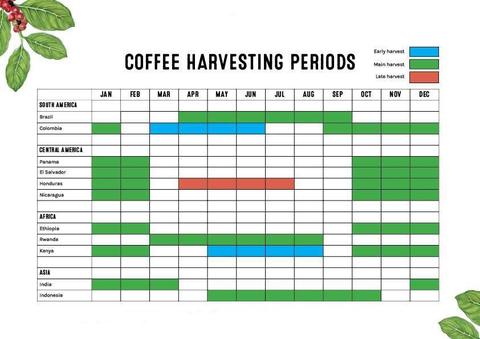Seasonal Coffee
Coffee has a lifecycle that takes it all the way from a seed within a fruit to your cup. Like any other fruit, coffee is picked at certain points on account of the ripeness and prime tastiness. Different countries have different calendars, as you can see in the image above..
What Do the Roasters Say?
We asked some of our incredible roasters what coffee’s seasonal nature meant for them, and their adaptable working habits.
Two Chimps – Two Chimps Coffee change their range every eight to ten months. The team roast carefully selected seasonal beans and pay close attention to the harvest times around the globe. Harvest times vary greatly: compare Columbia, which has two annual harvests, to Peru, which has a relatively short harvest of three months. Sourcing directly from small farms and ethical coffee importers means that Two Chimps can adapt to environmental changes and always ensure their speciality coffee beans are picked at their prime.
Working with real people and real harvests means that the Two Chimps range frequently changes. Once the farmer has harvested the coffee cherries and the beans have been roasted by Andy at Two Chimps, that season’s crop has been used and enjoyed. Environmental changes and evolving farming practices make it impossible to replicate coffee crops exactly. Hence, Two Chimps can’t do carbon copies and you’ve always got a new coffee to try! Two Chimps also roast some exciting limited editions from micro lots and trial projects. Limited edition coffees are often experimental, diverse and truly limited – they’re only around for a few months!
Casa Espresso – We roast coffee all year round. However, this doesn’t mean that coffee is picked, processed and continuously shipped. Coffee beans are the seed of the coffee fruit, or ‘cherry’. Coffee is just like other fruit trees- in the spring, the trees flower and the flowers are pollinated and produce fruit which matures and ripens during the summer.
Don’t be fooled into thinking that all these exotic coffee countries are dry and arid either- coffee requires high rainfall to produce good crops. Certain regions of India and Colombia have the highest rainfall in the world. In the same breath though rainfall and other environmental factors can have a significant impact on quality. For example, if the rain is steady during the summer, then the coffee cherries will mature steadily too. This means the farmworkers can easily pick the slowly developing cherries at their most ripe state, increasing quality. On the other hand if there is a period of drought followed by heavy rainfall the cherries can mature very quickly, so it is more likely that over-ripe (essentially defective) coffees will make their way into the harvest decreasing quality.
Another crucial stage of coffee processing is drying. If the coffee dries evenly and quickly, the resulting quality will be higher. But factors such as rainfall and humidity can plague the drying process, particularly by creating favourable conditions for mould growth which causes defective flavours.
Balance Coffee – Unlike our fortunate access to wines all year long, each coffee has its season and tastes best when enjoyed nearest to that season as possible. We embrace this change in coffee seasonality and focus on showcasing a wider variety of coffees throughout the year to our customer base. The Balance Coffee (link) subscription is a great example of that as we rotate the coffee each time so that you can experience a new coffee growing region and flavour each time whilst learning about the coffee origin.
Typically we introduce new speciality coffees every 4-6 weeks and buy in smaller micro lots which are often rare and unique due to the altitude in which these coffees are grown in. But for us, it’s all about our customers experiencing wonderful coffees from around the world and having the same access to coffee as you have within the wine industry.
Remember to support your local coffee roasters and their seasonal roasts and projects!

